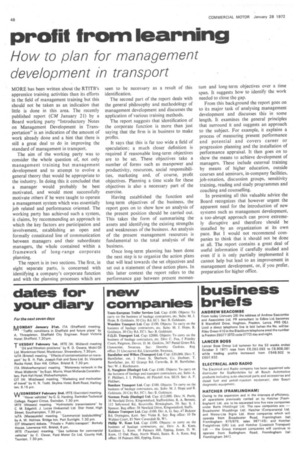profit from learning
Page 50

If you've noticed an error in this article please click here to report it so we can fix it.
How to plan for management development in transport
MORE has been written about the RTITB's apprentice training activities than its efforts in the field of management training but this should not be taken as an indication that little is done in this area. The recently published report (CM January 21) by a Board working party "Introductory Notes on Management Development in Transportation" is an indication of the amount of work already done and a hint that there is still a great deal to do in improving the standard of management in transport.
The aim of the working party was to consider the whole question of, not only management training but management development and to attempt to evolve a general theory that would be appropriate to the industry. In doing this it concluded that a manager would probably be best motivated, and would most successfully motivate others if he were taught to operate a management system which was essentially job related and performance oriented. The working party has achieved such a system, it claims, by recommending an approach in which the key factors are participation and involvement, establishing an open and formally constituted line of communication between managers and their subordinate managers, the whole contained within a framework of long-range corporate planning.
The report is in two sections. The first, in eight separate parts, is concerned with identifying a company's corporate function and with the planning processes which are seen to be necessary as a result of this identification.
The second part of the report deals with the general philosophy and methodology of management development and discusses the application of various training methods.
The report suggests that identification of the corporate function is more than just saying that the firm is in business to make profits.
It says that this is far too wide a field of speculation; a much closer definition is required if reasonable long-term objectives are to be set. These objectives take a number of forms such as manpower and productivity, resources, social responsibilities, marketing and, of course, profit objectives. Planning a time scale for these objectives is also a necessary part of the exercise.
Having established the function and long-term objectives of the business, the report goes on to show how an analysis of the present position should be carried out. This takes the form of summarising the assets and identifying the existing strengths and weaknesses of the business. An analysis of the present management resources is fundamental to the total analysis of the business.
Once long-term planning has been done the next step is to organize the action plans that will lead towards the set objectives and set out a statement of these action plans. In this latter context the report refers to the performance gap between present momen
turn and long-term objectives over a time span. It suggests how to identify the work needed to close the gap.
From this background the report goes on to its major task of analysing management development and discusses this in some length. It examines the general principles that surround it and suggests an approach to the subject. For example, it explains a process of measuring present performance and potential and covers career or progression planning and the installation of performance appraisal. It then goes on to show the means to achieve development of managers. These include external training by means of higher education, outside courses and seminars, in-company facilities, job-rotation, discussion groups, sensitivity training, reading and study programmes and coaching and counselling.
In presenting all this valuable advice the Board recognizes that however urgent the apparent need for the introduction of new systems such as management development, a too-abrupt approach can prove extremely disruptive and therefore should be installed by an organization at its own pace. But I would not recommend companies to think that it should not be done at all. The report contains a great deal of useful information if carefully studied and even if it is only partially implemented it cannot help but lead to an improvement in management development, or, if you prefer, preparation for higher office.
























































































